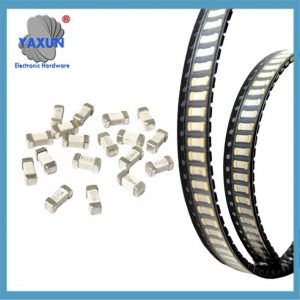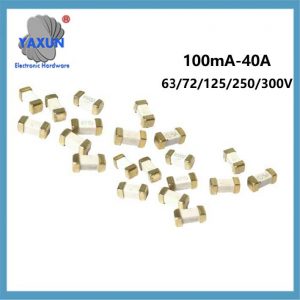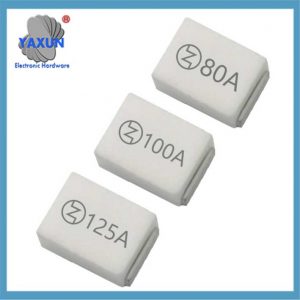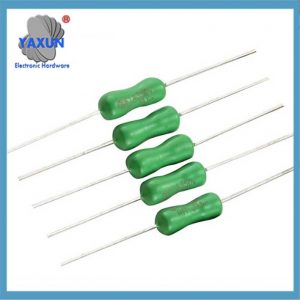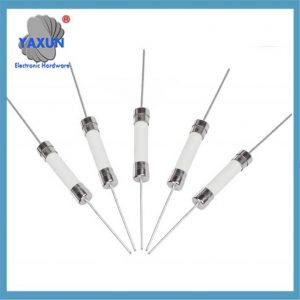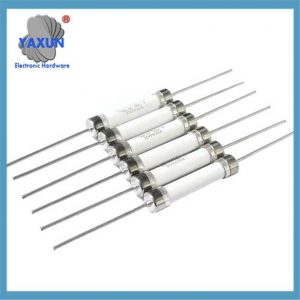La differenza fondamentale tra fusibili ad azione rapida e ad azione lenta. Le loro principali differenze risiedono nella velocità di fusione e nella capacità di resistere alle correnti impulsive. I fusibili ad azione rapida rispondono rapidamente e sono adatti per proteggere circuiti sensibili; i fusibili ad azione lenta possono resistere a sovracorrenti istantanee ed evitare falsi interventi.
Per quanto riguarda gli scenari di applicazione, si menziona che i fusibili ad azione rapida sono adatti per carichi resistivi e protezione IC, mentre i fusibili ad azione lenta sono adatti per carichi capacitivi/induttivi. Queste informazioni sono molto importanti poiché lo scenario applicativo errato impedirà l'avvio del dispositivo o la mancata protezione. È particolarmente sottolineato che i fusibili ad azione lenta devono essere utilizzati in occasioni con correnti di picco come gli alimentatori a commutazione.
In termini di principi tecnici, IL “caratteristiche di ritardo” dei fusibili ad azione lenta derivano da strutture e design dei materiali speciali, che consentono loro di assorbire energia e resistere agli impulsi. Questa spiegazione di principio è molto utile e può aiutare gli utenti a capire perché i fusibili ad azione rapida non possono semplicemente sostituire i fusibili ad azione lenta.
Suggerimenti pratici per la selezione dei parametri: La corrente nominale è 1.5-2 volte la corrente di lavoro. Tuttavia, è importante notare l'equivoco secondo cui più veloce è l'azione, meglio è. IL “lentezza” dei fusibili ad azione lenta è in realtà un riflesso della loro capacità di giudizio intelligente.
Sarebbe più chiaro pensare di organizzarlo in una tabella per mostrare il confronto. La tabella dovrebbe includere quattro dimensioni: Caratteristiche di fusione, carichi applicabili, applicazioni tipiche, e principi di sostituzione, in modo che gli utenti possano vederlo a colpo d'occhio. Per esempio, IL “resistenza alle sovratensioni” di un fusibile ritardato corrisponde a carichi capacitivi/induttivi, e le applicazioni tipiche sono alimentatori a commutazione e avviamento di motori.
La differenza principale tra ad azione rapida (colpo veloce) e ad azione lenta (colpo lento) i fusibili risiede nelle caratteristiche di fusione, scenari applicativi e resistenza alle sovratensioni. Il confronto specifico è il seguente:
IO. Differenza fondamentale
| Caratteristiche | Fusibile ad azione rapida | Fusibile ad azione lenta |
|---|---|---|
| Velocità di fusione | Risposta rapida, fusione rapida in caso di sovracorrente (livello di millisecondi) | Ritardo nella risposta, può resistere a brevi impulsi di corrente prima della fusione |
| Resistenza alle sovratensioni | Debole, facilmente erroneamente soffiato da una grande corrente istantanea | Forte, può assorbire energia per resistere ai picchi di accensione |
| Tipo di carico applicabile | Carico resistivo (come il filo riscaldante), circuito IC sensibile | Carico capacitivo/induttivo (come il motore, alimentazione elettrica commutabile) |
Ii. Scenario applicativo
Scenario applicabile con fusibile ad azione rapida
Circuito resistivo con corrente di lavoro stabile (bollitore elettrico, stufa);
Circuito che deve proteggere rapidamente dispositivi di valore (CIRCUITO INTEGRATO, Tubo MOS);
Apparecchiature elettroniche sensibili senza sovracorrente.
Scenari applicativi con fusibili ad azione lenta
Circuiti capacitivi con picchi di avviamento (carica dei condensatori elettrolitici degli alimentatori switching);
Carichi induttivi con elevate correnti di avvio (motori, compressori);
Terminali di ingresso/uscita di alimentazione e altri collegamenti soggetti a interferenze a impulsi.
III. Considerazioni sulla selezione
Corrente nominale: Generalmente 1.5-2 volte la corrente operativa massima dell'apparecchiatura per essere compatibile con le sovratensioni.
Principio di sostituzione:
La pausa veloce può essere sostituita con la pausa lenta per migliorare l'anti-interferenza (ad eccezione dei circuiti sensibili);
Non sostituire mai il contropiede lento con il contropiede veloce, altrimenti causerà il fusibile di avvio (come quando si avvia il motore).
Marcatura di distinzione:
Il contropiede è solitamente contrassegnato con la lettera F (Ad azione rapida), e la pausa lenta è contrassegnata con T (Ritardo).
IV. Principio tecnico
Meccanismo di ritardo a rottura lenta: Assorbire energia attraverso strutture speciali (come le leghe fuse), resistere temporaneamente alle correnti impulsive (come le correnti di carica dei condensatori), e fusibile solo in caso di sovraccarico continuo.
Meccanismo di interruzione rapida: Il fusibile ha una struttura fine ed è sensibile ai cambiamenti di corrente, rompersi immediatamente in caso di sovracorrente.
⚠️ Correzione malintesi: Pausa lenta non significa “Risposta lenta”, ma può distinguere tra corrente di guasto e corrente di impulso per evitare la falsa protezione.
 English
English Afrikaans
Afrikaans العربية
العربية বাংলা
বাংলা bosanski jezik
bosanski jezik Български
Български Català
Català 粤语
粤语 中文(简体)
中文(简体) 中文(漢字)
中文(漢字) Hrvatski
Hrvatski Čeština
Čeština Nederlands
Nederlands Eesti keel
Eesti keel Suomi
Suomi Français
Français Deutsch
Deutsch Ελληνικά
Ελληνικά हिन्दी; हिंदी
हिन्दी; हिंदी Magyar
Magyar Bahasa Indonesia
Bahasa Indonesia Italiano
Italiano 日本語
日本語 한국어
한국어 Latviešu valoda
Latviešu valoda Lietuvių kalba
Lietuvių kalba македонски јазик
македонски јазик Bahasa Melayu
Bahasa Melayu Norsk
Norsk پارسی
پارسی Polski
Polski Português
Português Română
Română Русский
Русский Cрпски језик
Cрпски језик Slovenčina
Slovenčina Slovenščina
Slovenščina Español
Español Svenska
Svenska ภาษาไทย
ภาษาไทย Türkçe
Türkçe Українська
Українська اردو
اردو Tiếng Việt
Tiếng Việt

